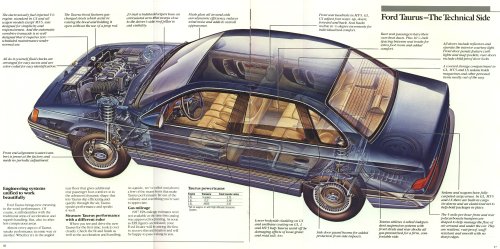
| 1986 - 1995 FORD TAURUS |
 |
 |
| Wheelbase, in. | 106.0 | 106.0 |
| Overall Length, in. | 192.0 | 193.0 |
| Overall Width, in. | 70.7 | 70.7 |
| Overall Height, in. | 54.1 | 55.5 |
| Curb Weight, lbs. | 3118 | 3285 |
| Cargo Volume, cu ft. | 18.0 | 83.1 |
| Fuel Capacity, gals. | 16.0 | 16.0 |
| Seating Capacity | 6/5(with bucket seats) | 6/8(with rear facing seat) |
| Front Headroom, in. | 38.3 | 38.5 |
| Max. Front Legroom, in. | 41.7 | 41.7 |
| Rear Headroom, in. | 37.6 | 38.1 |
| Min. Rear Legroom, in. | 37.7 | 36.9 |
| 1996 - 1998 FORD TAURUS | Sedan | Wagon |
| Wheelbase, in. | 108.5 | 108.5 |
| Overall Length, in. | 197.5 | 199.6 |
| Overall Width, in. | 73.0 | 73.0 |
| Overall Height, in. | 55.1 | 57.6 |
| Fuel Capacity, gals. | 16.0 | 16.0 |
| Seating Capacity | 6/5(with bucket seats) | 6/8(with rear facing seat) |
| Front Headroom, in. | 39.2 | 39.3 |
| Max. Front Legroom, in. | 42.6 | 42.6 |
| Rear Headroom, in. | 36.2 | 38.9 |
| Min. Rear Legroom, in. | 38.9 | 38.5 |
|
|
Production Years:
1986-1990
Trim Levels: L, GL, and MT5 Type: I-4 In-line OHV Induction System: Electronic central fuel injection Engine Controls: Electronic Engine Control (EEC-IV) computer Displacement: 2.5 Valves: 8 Horsepower, SAE net: 90 @ 4400 rpm Torque, SAE net: 130lb.-ft. @ 2600 rpm Description: The 2.5L engine is an in-line 4-cylinder with overhead valves and high-swirl, fast-burn combustion chamber design. Special features of the combustion chamber combine to produce a fast, efficient burn rate of the air/fuel mixture. The modified wedge-shaped combustion chambers are designed with a squish area that concentrates the compressed volume near the center of the chamber where the spark plug is located. A special shroud is built into the induction system at the intake valve that creates a pronounced swirling motion in the incoming fuel charge. The swirling motion of the charge produces a fast burn without premature detonation, extracting more power from each fuel droplet. Reliability: Very Good: If maintained properly, life expectancy is 150,000 miles and up. |
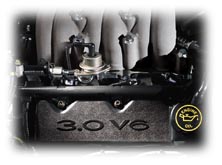 |
Production Years:
1986-Present
Trim Levels: L (86-92), GL (86-97), LX (86-99), SE (95) Type: V-6 60 degree OHV Induction System: Electronic multi-port fuel injection (86-90) Sequential multi-port fuel injection (91-95) Engine Controls: Electronic Engine Control (EEC-IV) computer Displacement: 3.0 Valves: 12 Horsepower, SAE net: 140 @ 4800 rpm Torque, SAE net: 160lb.-ft. @ 3000 rpm Description: Combustion chamber and intake valve port designs of the 3.0L engine were developed using input from Ford's European resources and computer-aided design technology. The process included the selection and testing of 12 different designs to determine the optimum configuration for high specific output and low specific fuel consumption. The configuration selected was a twin-squish compact chamber with a centrally located spark plug. Locating the spark plug in the center of the wedge shaped chamber allows high compression ratio of 9.25:1 using regular unleaded fuel. The induction system on the 3.0L V-6 is electronically controlled multiple-port fuel-injection that delivers a precise amount of fuel to the intake valves for good fuel mixing during the intake process. Reliability: Very Good. If properly maintained life expectancy is 180,000 miles and up. |
|
|
Production Years:
1988-1995
Trim Levels: L (88-91), GL (88-95), LX (88-95), SE (95) Type: V-6 90 degree OHV w/ balance shaft Induction System: Electronic multi-port fuel injection (86-90) Sequential multi-port fuel injection (91-95) Engine Controls: Electronic Engine Control (EEC-IV) computer Displacement: 3.8 Valves: 12 Horsepower, SAE net: 140 @ 3800 rpm Torque, SAE net: 215lb.-ft. @ 2200 rpm Description: The high compression 3.8L features a tuned intake manifold and multi-port electronic fuel injection with the injector nozzles mounted directly on the cylinder heads. The 3.8L also has a special counter-rotating balance shaft which helps control engine vibration. Reliability: Average. If properly maintained life expectancy is 180,000 miles and up. Although, this engine is known to have a problem with its head gaskets. Problems usually occur with blown head gaskets around 60,000-90,000 miles. This usually occurs near the number one cylinder and causes coolant to leak near engine and billows of white exhaust from the muffler. After, being repaired problem could reoccur. This engine is used in the Ford Windstar, Mercury Sable, Mercury Cougar, and Lincoln Continental. Most problems seem to surface after coolant flushes. |
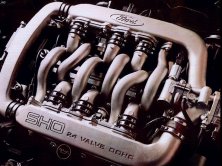 |
Production Years:
1989-1995
Trim Level: SHO (89-95) Type: V-6 DOHC Induction System: Sequential multi-port fuel injection Engine Controls: Electronic Engine Control (EEC-IV) computer Displacement: 3.0 Valves: 24 Horsepower, SAE net: 220 @ 6200 rpm Torque, SAE net: 200lb.-ft. @ 4800 rpm Description: The fuel-injected 3.0L SHO 24-valve V-6 has four valves per cylinder - two for intake, two for exhaust - that significantly increase the engine's air intake for high power output. Dual high-lift overhead camshafts actuating the valves in each cylinder contribute as well to the engine's super high output performance. Multivalving allows for an optimized spark plug location in the cylinders to burn the fuel-air mixture rapidly and evenly. Engine breathing and combustion are further improved by components such as a dual runner tuned intake manifold and a tuned dual exhaust system. A sequential multi-port electronic fuel-injection system, controlled by Ford's advanced EEC-IV computer, provides precise fuel metering to each cylinder and improves performance under all operating conditions. Reliability: Excellent. The Yamaha designed engine is very reliable. Some 1989 SHOs have exceeded 200,000 miles. |
 |
Production Years:
1993-1995
Trim Level: SHO (93-95) Type: V-6 DOHC Induction System: Sequential multi-port fuel injection Engine Controls: Electronic Engine Control (EEC-IV) computer Displacement: 3.2 Valves: 24 Horsepower, SAE net: 220 @ 6000 rpm Torque, SAE net: 215lb.-ft. @ 4800 rpm Description: The fuel-injected 3.2L SHO 24-valve V-6 has four valves per cylinder - two for intake, two for exhaust - that significantly increase the engine's air intake for high power output. Dual high-lift overhead camshafts actuating the valves in each cylinder contribute as well to the engine's super high output performance. Multivalving allows for an optimized spark plug location in the cylinders to burn the fuel-air mixture rapidly and evenly. Engine breathing and combustion are further improved by components such as a dual runner tuned intake manifold and a tuned dual exhaust system. A sequential multi-port electronic fuel-injection system, controlled by Ford's advanced EEC-IV computer, provides precise fuel metering to each cylinder and improves performance under all operating conditions. Reliability: Excellent. The Yamaha designed engine is very reliable. The 3.2L has possibility to exceeded 200,000 miles with proper care. |
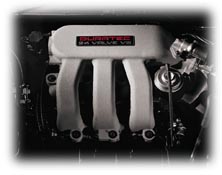 |
Production Years:
1996-present
Trim Level: LX, SE Type: V-6 DOHC Induction System: Sequential multi-port fuel injection Engine Controls: Electronic Engine Control (EEC-V) computer Displacement: 3.0 Valves: 24 Horsepower, SAE net: 200 @ 5750 rpm Torque, SAE net: 200lb.-ft. @ 4500 rpm Description: Dual intake runners that increase air flow for improved low-end response, and it's remarkably quiet. The block and heads, made of high-strength aluminum, save weight. Reliability: Unknown. New engine. Email your comments. |
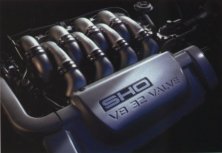 |
Production Years:
1996-present
Trim Level: SHO Type: V-8 60 degree DOHC Induction System: Sequential multi-port fuel injection Engine Controls: Electronic Engine Control (EEC-V) computer Displacement: 3.4 Valves: 32 Horsepower, SAE net: 235 @ 6100 rpm Torque, SAE net: 230lb.-ft. @ 4800 rpm Description: Reliability: Unknown. New engine. Email your comments. |